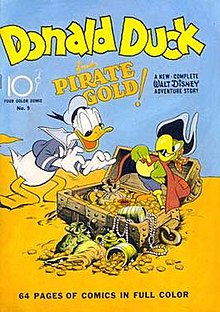
The Junior Woodchucks of the World is a fictional scouting organization appearing in Disney comics and the DuckTales animated television franchise, most notably in adventures featuring Disney characters Huey, Dewey, and Louie as members.

Uncle Scrooge is a Disney comic book series starring Scrooge McDuck, his nephew Donald Duck, and grandnephews Huey, Dewey, and Louie, and revolving around their adventures in Duckburg and around the world. It was first published in Four Color Comics #386, as a spin-off of the popular Donald Duck series and is still presently ongoing. It has been produced under the aegis of several different publishers, including Western Publishing, Gladstone Publishing, Disney Comics, Gemstone Publishing, Boom! Studios, and IDW Publishing, and has undergone several hiatuses of varying length. Despite this, it has maintained the same numbering scheme throughout its six decade history, with only IDW adding a secondary numbering that started at #1.
Disney comics are comic books and comic strips featuring characters created by the Walt Disney Company, including Mickey Mouse, Donald Duck and Scrooge McDuck.
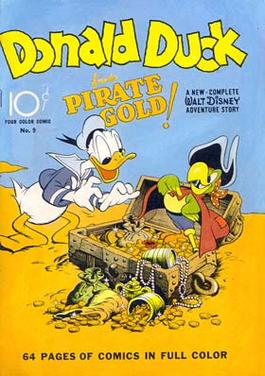
"Donald Duck Finds Pirate Gold" is a Disney comics story starring Donald Duck that was originally printed in Four Color #9 in October 1942. The script was by Bob Karp and illustrated by Carl Barks and Jack Hannah. The story is significant for launching the first American Donald Duck adventure comic series, and for being Barks' first duck comics work.
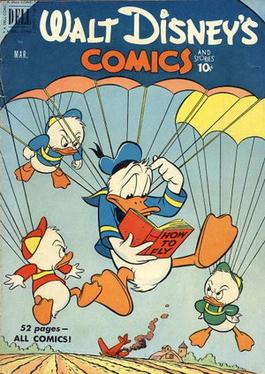
Walt Disney's Comics and Stories, sometimes abbreviated WDC&S, is an American anthology comic book series featuring characters from The Walt Disney Company's films and shorts, including Donald Duck, Scrooge McDuck, Mickey Mouse, Chip 'n Dale, Li'l Bad Wolf, Scamp, Bucky Bug, Grandma Duck, Brer Rabbit, Winnie the Pooh, and others. With more than 700 issues, Walt Disney's Comics & Stories is the longest-running Disney comic book in the United States, making it the flagship title, and is one of the best-selling comic books of all time.
"Pluto Saves the Ship" is a 51-page black-and-white comic book story scripted by writers Carl Barks, Jack Hannah and Nick George from a plot devised possibly by a publisher, and drawn by Disney animation layout artist Bruce Bushman. It was originally printed in Dell Comics' Large Feature Comics #7 in July 1942, and is one of the first American Disney comics ever made that was not reprinted from newspaper comic strips. It is Barks' first comic book work, and Pluto's first comic book adventure. This was followed in October 1942 by Donald Duck Finds Pirate Gold, the Disney characters' first entry in Dell's Four Color anthology series.
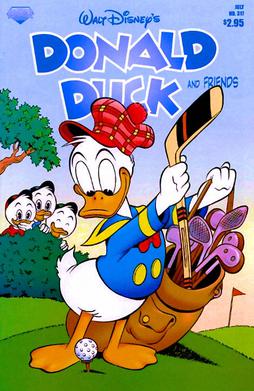
Donald Duck, also known as Donald Duck and Friends, is an American Disney comic book series starring the character Donald Duck and published by various publishers from October 1942 to June 2017. As with many early Disney comics titles, Donald Duck began as individual issues of Dell Comics' Four Color one-shots series. It was published as its own regular series in November 1952, starting with issue #26.
Paul Murry was an American cartoonist and comics artist. He is best known for his Disney comics, which appeared in Dell Comics and Gold Key Comics from 1946 to 1984, particularly the Mickey Mouse and Goofy three-part adventure stories in Walt Disney's Comics and Stories.

The International Network of Disney Universe Comic Knowers and Sources (I.N.D.U.C.K.S.) or Inducks is a freely available database aiming to index all Disney Universe comics ever printed in the world, created and maintained by both amateurs and professionals. It is an international project which provides indexes of around 130,000 Disney comic publications worldwide. It is distributed with its own licence.
Walt Disney Comics Digest is one of three digest size comics published by Gold Key Comics in the early 1970s. The other two were Mystery Comics Digest and Golden Comics Digest. It was the first digest-sized regular Disney comic published in the US, and was very successful, offering relief from the company's slipping comic book sales.
Scamp is a canine Disney comics character, the son of Lady and Tramp, all of whom appear in the 1955 animated film Lady and the Tramp. Scamp is featured in comic strips and comic books of his own since the 1950s. In the final scene of the film, the dogs have a litter of puppies, including three girl pups who look like Lady, and a mischievous, restless boy pup who resembles Tramp. The puppies are unnamed in the film and only appear in one scene, but the little boy puppy made an impression, and King Features Syndicate launched a comic strip a few months after the film's release.

Kalle Anka & C:o is a Swedish weekly Disney comics magazine, published by Egmont. The 52-page comic, launched in September 1948, is the overall best-selling Swedish comic magazine. In the early years, the comic printed translated stories from the United States, including Walt Disney's Comics and Stories, Four Color and other Dell Comics Disney titles. As Disney comics production waned in the United States in the 1960s, Kalle Anka began printing more European-produced content, from Scandinavia and Italy. Now, Kalle Anka & C:o and its Scandinavian sister editions Anders And & Co. (Denmark) and Donald Duck & Co (Norway) are identical, apart from the language.

Mickey Mouse is a Disney comic book series that has a long-running history, first appearing in 1943 as part of the Four Color one-shot series. It received its own numbering system with issue #28, and after many iterations with various publishers, ended with #330 from IDW Publishing.

Silly Symphonies: The Complete Disney Classics is a book series which reprints Walt Disney's Silly Symphony Sunday comic strip, drawn by several different Disney artists from 1932 to 1945. The strip was published by King Features Syndicate. The strip often introduced new Disney characters to the public, including its first comic character, Bucky Bug. The series was published by The Library of American Comics from 2016 to 2019.
Donald Duck is an American comic strip by the Walt Disney Company starring Donald Duck, distributed by King Features Syndicate. The first daily Donald Duck strip debuted in American newspapers on February 7, 1938. On December 10, 1939, the strip expanded to a Sunday page as well. Writer Bob Karp and artist Al Taliaferro worked together on the strip for more than 30 years. The strip ended in May 1995.
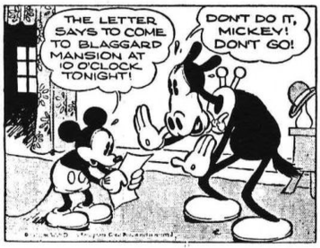
Mickey Mouse is an American newspaper comic strip by the Walt Disney Company featuring Mickey Mouse and is the first published example of Disney comics. The strip debuted on January 13, 1930, and ran until July 29, 1995. It was syndicated by King Features Syndicate.

Mickey Mouse Magazine is an American Disney comics publication that preceded the popular 1940 anthology comic book Walt Disney's Comics and Stories. There were three versions of the title – two promotional giveaway magazines published from 1933 to 1935, and a newsstand magazine published from 1935 to 1940. The publication gradually evolved from a 16-page booklet of illustrated text stories and single-page comic panels into a 64-page comic book featuring reprints of the Mickey Mouse and Donald Duck comic strips.
Silly Symphony is a weekly Disney comic strip that debuted on January 10, 1932, as a topper for the Mickey Mouse strip's Sunday page. The strip featured adaptations of Walt Disney's popular short film series, Silly Symphony, which released 75 cartoons from 1929 to 1939, as well as other cartoons and animated films. The comic strip outlived its parent series by six years, ending on October 7, 1945.
Uncle Remus and His Tales of Br'er Rabbit is an American Disney comic strip that ran on Sundays from October 14, 1945, to December 31, 1972. It first appeared as a topper strip for the Mickey Mouse Sunday page, but after the first few years, almost always appeared on its own. The strip replaced the 1932-1945 Silly Symphony strip, which had spent its final year on gag strips featuring Panchito from The Three Caballeros.
Donald Duck and Other Adventures, also known as Paperino giornale, is a 1937–40 weekly Italian Disney comics magazine published by Mondadori. The comic was launched by Federico Pedrocchi, Mondadori's art director, as a companion to the existing weekly Topolino magazine. Paperino published 149 issues from 30 December 1937 to 26 October 1940, at which point it was merged with Topolino.
